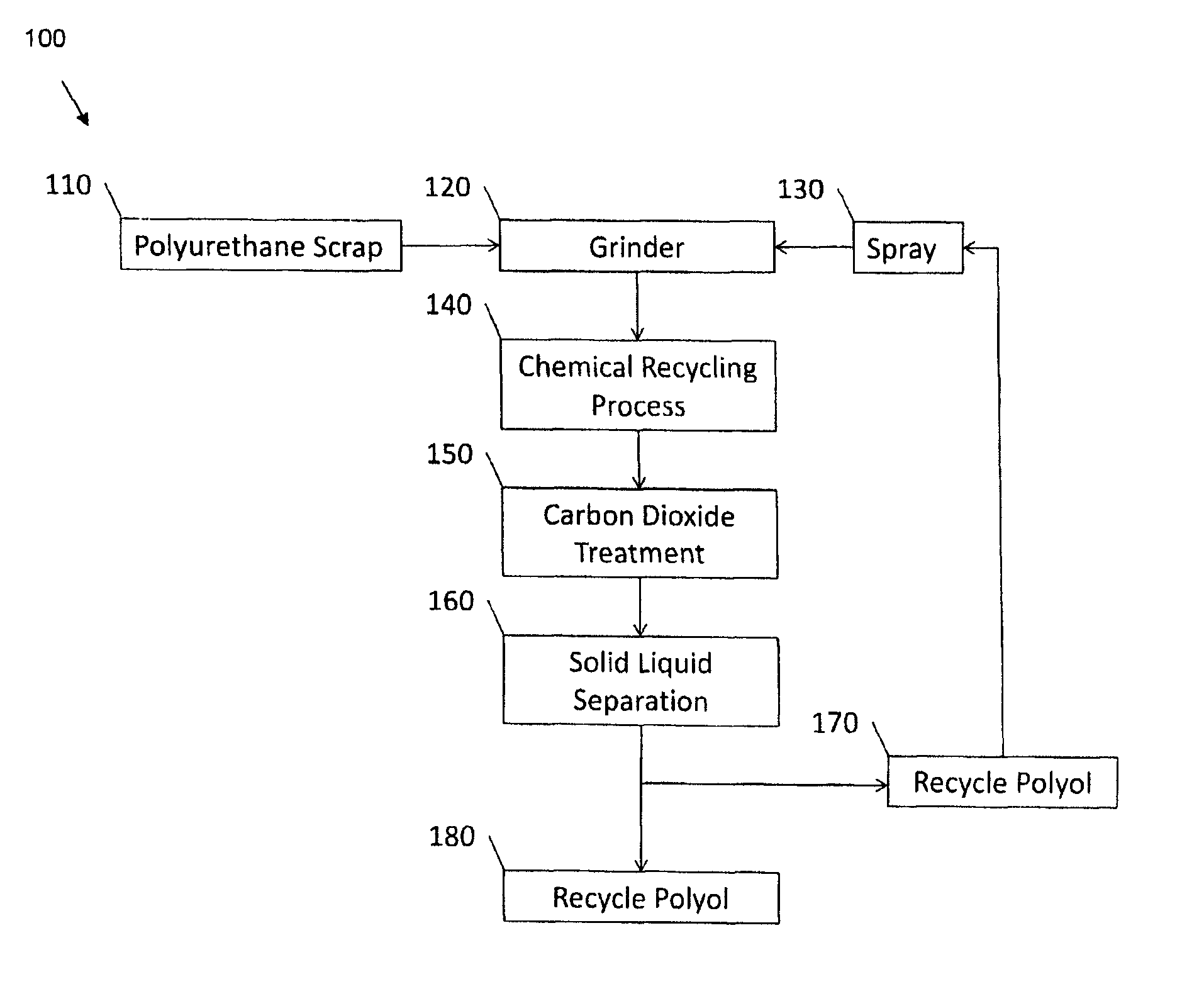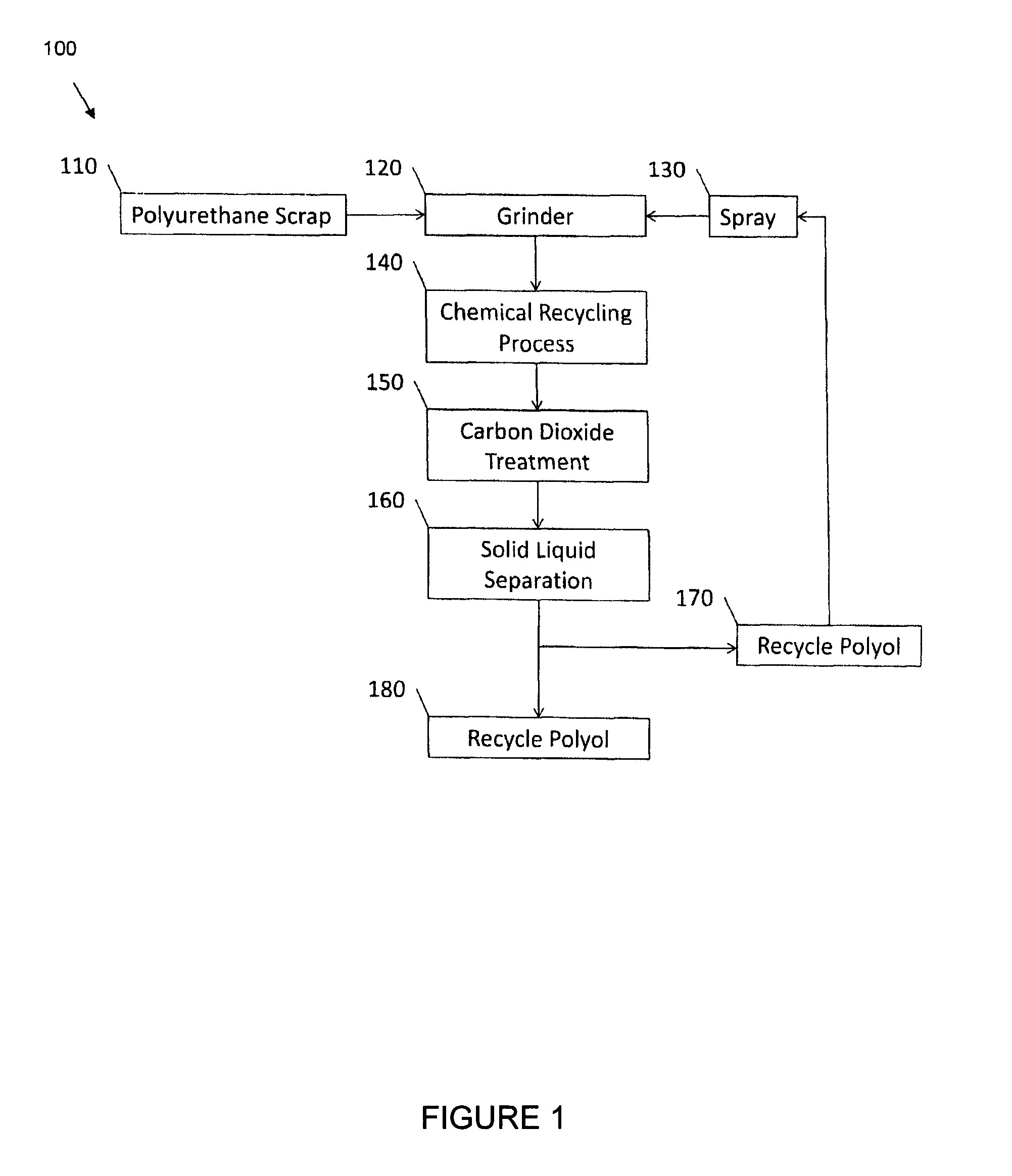Process to Improve the Yield of Chemical Polyurethane Foam Recycling
a polyurethane foam and polyurethane technology, applied in the field of improving the efficiency of the chemical polyurethane foam recycling process, can solve the problems of urea linkages in the polymer, limited resistance to applied load, and inability to recover the original shape slowly, so as to improve the efficiency of chemical recycling
- Summary
- Abstract
- Description
- Claims
- Application Information
AI Technical Summary
Benefits of technology
Problems solved by technology
Method used
Image
Examples
example 1
Wet Grinding of Polyurethane Foam
[0084]Example 1 illustrates the improvement of foam yield from the wet grinding process over dry grinding process. Kingspan's rigid was used in both the dry and wet grinding process test.[0085]When grinding the foam dry, lots of fine foam dust would be blown out of the grinder. A dry grinding test showed that approximately 18.7 wt % of the foam was lost. Wet grinding of the rigid foam is carried out with the following procedures:[0086]a. Place 500 g of foam blocks into the grinder[0087]b. Add approximately 250 g of Recycle Polyol into the grinder[0088]c. Spray 250 g of recycle polyol into the grinder while grinding.[0089]d. Grind for 1 minute
[0090]The wet grinding results in 4.2 wt % loss of the foam, which is a 76% improvement over the dry grinding foam yield. The polyurethane chemical recycling process can be conducted in various recipes which are illustrated in the following table and examples:[0091]Recipe A Recipe B Recipe C[0092]Polyurethane 66....
example 2
Chemical Polyurethane Foam Recycling Process with Recipe A
[0096]Example 2 illustrates the chemical polyurethane foam recycling process with the foam block ground wet with the procedure as in Example 1. The chemical polyurethane recycling process was carried out with procedures that are listed as follows:[0097]a. Dissolve 5 g of NaOH in 20 g DEA at 85 degree Celsius[0098]b. Add DEA mixture with 225 g of DEG and increase the solution temperature to 185 degree Celsius[0099]c. Add 1000 g of the wet ground polyurethane to the solution and maintain the solution temperature below 200 degree Celsius[0100]d. Once all the polyurethane pieces have dissolved, cool down the solution to 65 degree Celsius and filter. Depending on the type of polyurethane, the final solution might separate into two phases.
example 3
Chemical Polyurethane Foam Recycling Process with Recipe B
[0101]Example 3 illustrates the chemical polyurethane foam recycling process with the foam block ground wet with the procedure as in Example 1. The chemical polyurethane recycling process was carried out with procedures that are listed as follows:[0102]a. Dissolve 5 g of NaOH in 20 g DEA at 85 degree Celsius[0103]b. Add DEA mixture with 225 g of DEG and heat the solution to 185 degree Celsius[0104]c. Add 750 g of the wet ground polyurethane to the solution and maintain the solution temperature below 200 degree Celsius[0105]d. Once all the polyurethane pieces have dissolved, cool down the solution to 65 degree Celsius and filter. Depending on the type of polyurethane, the final solution might separate into two phases.
PUM
| Property | Measurement | Unit |
|---|---|---|
| pressures | aaaaa | aaaaa |
| densities | aaaaa | aaaaa |
| densities | aaaaa | aaaaa |
Abstract
Description
Claims
Application Information
 Login to View More
Login to View More - R&D
- Intellectual Property
- Life Sciences
- Materials
- Tech Scout
- Unparalleled Data Quality
- Higher Quality Content
- 60% Fewer Hallucinations
Browse by: Latest US Patents, China's latest patents, Technical Efficacy Thesaurus, Application Domain, Technology Topic, Popular Technical Reports.
© 2025 PatSnap. All rights reserved.Legal|Privacy policy|Modern Slavery Act Transparency Statement|Sitemap|About US| Contact US: help@patsnap.com


